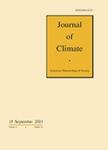版权所有:内蒙古大学图书馆 技术提供:维普资讯• 智图
内蒙古自治区呼和浩特市赛罕区大学西街235号 邮编: 010021

作者机构:NOAA Geophys Fluid Dynam Lab Princeton Univ Forrestal Campus201 Forrestal Rd Princeton NJ 08540 USA Univ Corp Atmospher Res Boulder CO USA Princeton Univ Atmospher & Ocean Sci Program Princeton NJ 08544 USA
出 版 物:《JOURNAL OF CLIMATE》 (气候杂志)
年 卷 期:2016年第29卷第7期
页 面:2375-2394页
核心收录:
学科分类:07[理学] 070601[理学-气象学] 0706[理学-大气科学]
基 金:MAPP Intra Americas Seas proposal - NOAA/Climate Program Office
主 题:Climate models ENSO Atm/Ocean Structure/ Phenomena Models and modeling Tropical cyclones Circulation/ Dynamics
摘 要:Tropical cyclone (TC) activity in the North Pacific and North Atlantic Oceans is known to be affected by the El Nino-Southern Oscillation (ENSO). This study uses the GFDL Forecast Oriented Low Ocean Resolution Model (FLOR), which has relatively high resolution in the atmosphere, as a tool to investigate the sensitivity of TC activity to the strength of ENSO events. This study shows that TCs exhibit a nonlinear response to the strength of ENSO in the tropical eastern North Pacific (ENP) but a quasi-linear response in the tropical western North Pacific (WNP) and tropical North Atlantic. Specifically, a stronger El Nino results in disproportionate inhibition of TCs in the ENP and North Atlantic, and leads to an eastward shift in the location of TCs in the southeast of the WNP. However, the character of the response of TCs in the Pacific is insensitive to the amplitude of La Nina events. The eastward shift of TCs in the southeast of the WNP in response to a strong El Nino is due to an eastward shift of the convection and of the associated environmental conditions favorable for TCs. The inhibition of TC activity in the ENP and Atlantic during El Nino is attributed to the increase in the number of days with strong vertical wind shear during stronger El Nino events. These results are further substantiated with coupled model experiments. Understanding of the impact of strong ENSO on TC activity is important for present and future climate as the frequency of occurrence of extreme ENSO events is projected to increase in the future.